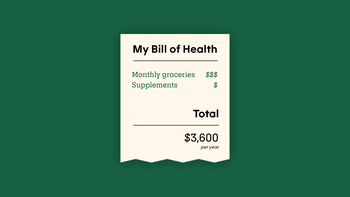
GoodRx Guide
Celiac Disease: Your GoodRx Guide
Comprehensive information for you or a loved one — including treatment options and discounts on popular medications.Celiac disease is an autoimmune condition in which eating gluten leads to intestinal damage.
Gluten is a protein found in grains, like wheat, barley, and rye. When people with celiac disease eat gluten, their own immune system attacks the lining of their intestine. This can cause lasting health problems.
In the U.S., it’s estimated that about 2 million people have celiac disease. Scientists aren’t sure why, but the number of people with celiac disease seems to be rising over time. This may be because of better diagnostic tests and increased awareness.
Between 1975 and 2000, the number of people with celiac disease in the U.S. increased 500%.
Celiac disease is different from wheat allergy or gluten intolerance:
Wheat allergy: An allergic reaction to wheat. It causes itchy throat, hives, wheezing, congestion, and even anaphylaxis. For people with this allergy, symptoms typically develop within a few hours of eating foods containing wheat.
Gluten intolerance: Your body has a difficult time breaking down gluten. This can lead to symptoms that overlap with those of celiac disease. Unlike celiac disease, this condition doesn’t cause long-term damage to the intestines.
Causes
When you have celiac disease, eating gluten triggers an abnormal attack by your immune system. This damages the lining of the small intestine.
Like most autoimmune diseases, it’s not clear what causes your immune system to attack your own body. Most likely, it is caused by a combination of factors, including your genes and environment.
One of the biggest risk factors for celiac disease is your genes. In fact, 90% to 95% of people with celiac disease have one of two abnormal genes. And if you have an immediate family member with celiac disease, you have a 1 in 10 chance of having it, too.
If an identical twin has celiac disease, their twin has a 75% to 80% of also having the disease. This means that genetics play a very strong role in determining who develops celiac disease.
Certain environmental factors can increase your risk for celiac disease. These include:
Whether you were breastfed as an infant
The age at which you started eating gluten
Childhood viral infections
Your individual gut microbiome
Who gets celiac disease?
Anyone can get celiac disease, but it’s more likely in certain groups of people:
Women
Children
White people
People from Western countries
People who have another autoimmune disease
Women are 2 to 3 times more likely than men to be diagnosed with celiac disease.
Symptoms
Common symptoms
Not everyone with celiac disease will have the same symptoms. The most common symptoms of celiac disease are caused by inflammation in the small intestine. This leads to signs and symptoms such as:
Abdominal pain
Bloating
Diarrhea
Constipation
Nausea
Vomiting
Weight loss
More than half of people with celiac disease will also develop problems that are not related to the digestive system. These include:
Growth problems
Rashes (most commonly dermatitis herpetiformis)
Numbness and tingling
Chronic headaches
Iron-deficiency anemia
Mouth blisters (canker sores)
Joint or bone pain
Complications
If celiac disease is not treated, it can lead to a wide range of problems, such as:
Increased risk of developing another autoimmune disease
Problems getting pregnant
The earlier you are diagnosed with celiac disease and treated, the less likely you are to develop complications.
Diagnosis
If you’re concerned about celiac disease, talk to your healthcare provider. You can also start by checking out the Celiac Disease Foundation symptom assessment tool to see whether your symptoms might be caused by celiac disease.
When you meet with your provider, they will talk to you about your symptoms, and do a physical exam. They may also suggest blood tests to look for celiac disease antibodies and genes. To get the most accurate test results, it is important to have your blood drawn before you start a gluten-free diet.
In some cases, your provider may also refer you to a gastroenterologist (GI doctor) for an endoscopy. For this test, a long, thin camera is inserted into your stomach and beyond, to look at the small intestine. The gastroenterologist will probably take small biopsies (which are small samples of tissue) to look at under a microscope.
If your test results don’t fit with a diagnosis of celiac disease — but you still have symptoms when you eat gluten — your provider might diagnose you with gluten intolerance.
Treatments
The main treatment for celiac disease is avoiding all forms of gluten. This can be challenging at first. Meeting with a nutritionist can help you learn to eat a gluten-free diet while still getting enough fiber, vitamins, and nutrients.
Some foods that are technically gluten-free (like oats) can contain gluten because they are often contaminated by wheat during the manufacturing process. So it’s best to avoid eating oats unless they are labeled “gluten-free.”
One quick and easy way to tell whether packaged food is gluten-free is to check the allergens list and avoid anything that says “contains wheat.” It’s a good idea for people with celiac disease to become comfortable reading ingredient lists to look for any gluten-containing ingredients. A comprehensive list can be found at the Celiac Disease Foundation.
Currently, there are no medications that can cure celiac disease, but researchers are developing clinical trials to investigate drugs that may be helpful in the future.
Living
Is it expensive to eat gluten-free?
If you’re making the transition to a gluten-free diet, you might experience some sticker-shock when shopping for food: In a cost-comparison at two grocery store chains, gluten-free products were 242% more expensive than regular products.
Rest assured, however, that a gluten-free diet doesn’t have to break the bank! Venturing out of the “gluten-free aisle” is a great way to save money:
Increase your intake of fresh, unprocessed foods, like fruits, vegetables, lean meats, and eggs.
Look for foods that are naturally gluten-free (like corn-based cereal or popcorn treats).
Cook with grains that are gluten-free, such as quinoa, buckwheat, and amaranth.
Learn to make homemade cookies and treats using gluten-free flours, like almond flour or coconut flour.
Where can I get more information?
Living with celiac disease is a life-long journey. Connecting with the celiac community can provide you with information, resources, and hope:
Common concerns
Gluten is a type of protein found in many grains, including wheat, barley, and rye. It is also found in the seeds that are ground to make flour. It affects the elasticity of dough, often acting as a “glue” that holds dough together. This is what gives certain foods their chewy texture.
In celiac disease, eating gluten causes an abnormal immune reaction that attacks the gut lining. This causes inflammation and damage to the intestine.
In gluten intolerance, the gut has a hard time digesting gluten. This can cause digestive discomfort, but there isn’t any damage to the intestine itself.
In both cases, eating gluten can cause uncomfortable symptoms that are improved by a gluten-free diet.
People with celiac disease should avoid all foods that contain gluten, which includes most:
Grains, such as wheat, rye, spelt, and barley
Pastas
Noodles
Breads
Cereals
Many sauces and gravies
Beer and malt beverages
Brewer’s yeast
Certain non-food products may contain gluten, such as:
Lipsticks
Toothpastes
Herbs and vitamin supplements
Drugs and over-the-counter medications
Play-Doh
Shampoo
Sunscreen
These products can be absorbed and cause reactions — especially if they are used near the mouth, like lipsticks and toothpastes are. A fuller list of ingredients to avoid can be found here.
Not all products are required to list ingredients, so if you suspect a non-food product is triggering your celiac symptoms, it may be best to switch to one that is specifically labeled “gluten-free.”
No. Several studies have looked at the connection between factors in early infancy and celiac disease. For example, the type of birth (cesarean or vaginal), breastfeeding, and the age when a baby starts to eat gluten may factor into why some people who are at risk for celiac disease end up developing it — but there are currently no proven ways to prevent the disease.
References
American College of Asthma, Allergy and Immunology. (2014). Wheat allergy.
Beyond Celiac. (2021). Celiac disease prevalence in women.
Beyond Celiac. (2021). Dermatitis herpetiformis.
Beyond Celiac. (2011). Hidden gluten in dental and cosmetic products.
Brown, J., et al. (2018). A viral trigger for celiac disease. PLoS Pathogens.
Caio, G., et al. (2019) Celiac disease: A comprehensive current review. BMC Medicine.
Celiac Disease Foundation. (2020). Incidence of celiac disease steadily increasing.
Celiac Disease Foundation. (2021). Sources of gluten.
Celiac Disease Foundation. (2021). Symptom assessment tool.
Celiac Disease Foundation. (2019). What is celiac disease?
ClinicalTrials.gov. (2017). A double-blind placebo controlled study to evaluate larazotide acetate for the treatment of celiac disease.
Cosnes, J., et al. (2008). Incidence of autoimmune diseases in celiac disease: Protective effect of the gluten-free diet. Clinical Gastroenterology and Hepatology.
Han, Y., et al. (2015) Association between celiac disease and any malignancy and gastrointestinal malignancy: A meta-analysis. Medicine.
King, J., et al. (2019). Incidence of celiac disease is increasing over time: A systematic review and meta-analysis. American Journal of Gastroenterology.
Leffler, D., et al. (2015). Extraintestinal manifestations of coeliac disease. Nature Reviews Gastroenterology and Hepatology.
Mearin, M. L. (2015). Celiac disease: Prevention in children. Digestive Disease.
Megiorni, F. et al. (2012). HLA-DQA1 and HLA-DQB1 in celiac disease predisposition: Practical implications of the HLA molecular typing. Journal of Biomedical Science.
National Institute of Diabetes and Digestive and Kidney Diseases. (2020). Definition & facts for celiac disease.
National Institute of Diabetes and Digestive and Kidney Diseases. (2020). Treatment for celiac disease.
Stevens, L., et al. (2008). Gluten-free and regular foods: cost-comparison. Canadian Journal of Dietetic Practice and Research.















